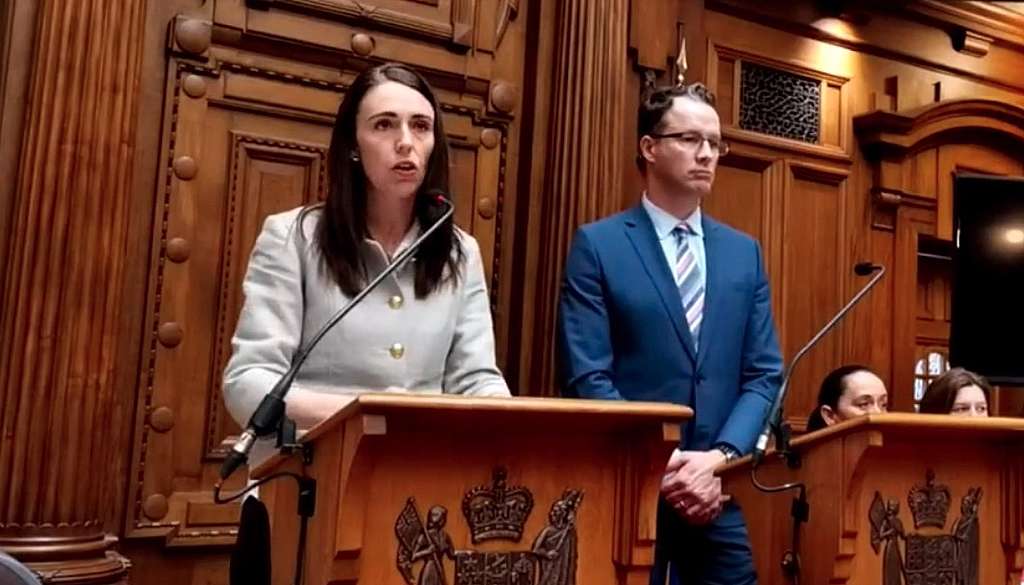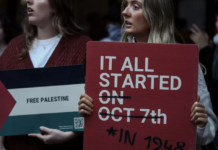
ANALYSIS: By Russel Norman, executive director of Greenpeace Aotearoa
Only people power can ensure genuine enduring progress on climate and people need to know the truth if they are to act on it. For that reason greenwashing is the enemy of progress on climate and where you stand on greenwashing is the Rubicon of our times.
I have spent decades of my life as a climate activist fighting various deliberate forms of climate science denial propagated by climate polluting companies and their allied political parties, politicians, lobby groups and commentators.
The good news is that we have mostly won that battle. The bad news is that they have a new tactic, greenwashing, which is now a major obstacle to progress on climate change. Greenwashing is when businesses or politicians give a false impression, or spin, on their products or policies to give the impression that they have a positive impact on the environment when they don’t.
We now face a new landscape in which even oil companies claim to be doing their bit for the climate with “carbon offsets” and “2050 net zero goals”. Their aim is to stop real action on climate by making people think it is all under control.
One of the jobs of the government is to sort out the real climate actions from the greenwashing, to hold industry to account. And of course, one of the jobs of the government is to not engage in greenwashing themselves.
The problem with some of the actions of the current Aotearoa New Zealand government is that rather than holding business to account for its greenwashing, on some vital climate issues the government is actually a proponent of greenwashing.
This greenwashing is closely linked to a wrong-headed theory of change which we hear repeatedly from this government — the idea that climate issues can only be solved through consensus, especially consensus with the polluters and their representatives. The idea that we can’t make real policy to cut climate pollution without the consent of the polluters and their representatives is dangerous and inconsistent with the history of making change.
There are fundamental conflicts in the climate policy space — some industries will not accept that they need to cut emissions. The attempt to gloss over these conflicts and seek consensus means the government adopts policies that the polluters will accept, and which consequently do not cut emissions. This policy outcome is then sold to the public as a great victory when in truth it is a defeat — it is greenwashed.
Before getting into the specifics of the problems I want to acknowledge that this government has done some good things on climate. The ban on new oil and gas exploration permits was a win, even though it excluded onshore Taranaki and allowed existing permits to be extended.
The cap on synthetic nitrogen fertiliser was a win, even though it is a very high cap which has yet to be enforced. Greenpeace publicly celebrated these wins and congratulated the government on making these decisions, even while pointing out their limitations.
I tried to provide a transparent assessment of the environmental performance of the Ardern government back in 2020. I spent a decade as Green Party co-leader and I know there are wins and losses in politics and that compromise is a reality of politics in a healthy democracy.
But honestly admitted compromise is one thing, and greenwashing is another.
There will always be arguments as to what is an acceptable political compromise. We need to separate the issue of what is an acceptable compromise to enter government from the issue of greenwashing. Determining what is an acceptable compromise for the Greens to join the Labour government is formally a matter of decision for the Green Party and the Labour Party rather than the climate movement.
People like me are entitled to our views of the compromise, but it is the Green Party and the Labour Party that have to decide if it’s worth it. I am not a member of the Green Party or the Labour Party.
The issue of greenwashing, however, is an issue which is of direct and immediate concern for the wider climate movement. This is because when the government sells their policies as great climate advances, when in reality they are not, it misleads the wider public and the climate movement.
People can think they don’t need to push hard on climate because it is under control, when it is not. We then need to spend our time highlighting and explaining why the claimed win is actually spin, rather than campaigning for meaningful action.
This undermines our ability to get more significant progress on climate policy because the power and leadership to get progress on climate (like all other progressive issues) comes from civil society and if civil society is disarmed by greenwashing then climate policy follows dead end paths, stalls or stops.
But why is greenwashing the biggest challenge the climate movement faces at the moment. How did we get here?
Goals remain unchanged, but tactics evolve
As I mentioned above, the first thing to understand is that climate policy is unavoidably and irrevocably conflictual, and hence political. That is because on the one hand the enduring overarching goal of big climate polluters in the fossil fuel business and industrial agribusiness is to prevent government regulations that will force them to cut their climate emissions.
While on the other hand the climate movement aims for emission cuts to achieve a stable climate.
This is a fundamental conflict globally, and in Aotearoa, and no amount of pseudo consensus can wish this conflict away.
Big climate polluters believe, rightly, that government regulation and pricing to drive emissions reductions threatens their business models and profitability. Other sectors of the economy, such as IT, can more easily adapt to a low carbon future, but those businesses in the industries like coal and synthetic fertiliser can’t adapt, and they intend to fight efforts to cut emissions all the way.
While their goal of preventing government regulation to force reductions in emissions has remained consistent, their tactics to achieve this goal have changed. And it is understanding the way their tactics have evolved that it becomes clear just how problematic the current government’s climate policies have become.
At the beginning the tactic they used was to deny the compelling weight of scientific evidence supporting the theory of human induced climate change. Climate denial was stock in trade for many right wing parties and agribusiness and oil industry lobby groups from the 1990s through to the 2010s.
But after a while that stopped working so they changed tactics to stressing uncertainty especially in the 2000s. They said climate change might be a thing, but there is so much uncertainty so we shouldn’t do anything about it. They played up the nature of scientific inquiry — that theories are not beyond questioning because they are not religious texts — to emphasise uncertainty and the need for delay. It was really just another form of climate denialism.
Billions spent on climate denialism
The polluting industries spent billions promoting climate denialism and uncertainty in order to block government regulation to cut emissions. They bought politicians, public relations firms and sadly some scientists to promote these ideas to delay action on climate. Their ideas were reproduced widely by the conservative commentariat, and many still are.
I spent many years of my life fighting climate denialism and eventually through the efforts of millions of climate activists we (mostly) won the battle against climate denialism. There are now few major governments or corporations or industry lobby groups that rely on climate denialist arguments to block government regulation to cut emissions.
Straight out climate science deniers have been pushed to the margins like Groundswell or the Act Party.
But the goal of the fossil fuel and agribusiness polluters remains consistent — they still want to stop government regulation to cut emissions — so they need a new tactic. And that tactic is greenwashing.
These days the polluters and their representatives say, “yes climate change is a thing” and “yes we should do something about it and you will be happy to know that we are doing something about it.”
Hence, they argue, there is no need for government regulation. Even though they spent the last 30 years blocking every attempt to reduce emissions and even denying climate science, they argue that they now take it seriously and there is absolutely no need for the government to do anything.
And what they are doing is often nonsense like net carbon zero targets in 2050 or buying offshore carbon credits or an industry controlled pricing mechanism like He Waka Eke Noa, or nitrification inhibitors etc. They don’t actually cut emissions in any significant way.
The purpose of greenwashing may seem relatively retail when it is done by a single company to sell stuff to consumers, but at a systemic level the purpose of greenwashing is to head off government attempts to introduce regulations and pricing that will force emission reductions.
There are of course some corporations and governments taking significant actions to cut emissions, but there are also many corporate and government actions that are just greenwashing.
Separating out the genuine climate actions from greenwashing is something that defines the climate politics of our time. And this is why the approach taken by the New Zealand government is so very problematic. People assume that the Climate Minister, especially a Green Party Climate Minister, will not perpetuate greenwashing, and will call it out, but it has not always been the case with James Shaw, and that makes it all the more insidious.
Government greenwashes the biggest polluter: Agribusiness
Which brings us to the problem with the current New Zealand government climate policy. Climate policy in this country mostly boils down to what you are doing about agribusiness emissions (biogenic agriculture emissions alone are about 50 percent of emissions) and transport (20 percent). The rest matters too but if you aren’t tackling these two then you aren’t tackling climate change.
Transport policy has not been great from a climate perspective but here I want to focus on the bigger problem — agribusiness — particularly intensive dairy.
We have had the same Prime Minister and the same Climate Minister for the nearly five years of this government. There have been a plethora of nice sounding climate announcements — the PM said that climate was her generation’s “nuclear free moment”, we’ve had the so-called Zero Carbon Act, a climate emergency declaration, an independent climate commission established, emissions reductions plans, improved nationally determined targets for reduction, signed the global methane pledge etc.
But there is still no effective government policy to cut emissions from agribusiness, by far the biggest polluter.
The problem is not just that the government is doing virtually nothing to cut emissions from agribusiness, the problem is that it is saying that it is taking climate change seriously.
It is equivalent to the Australian government doing nothing about coal or the Canadian government doing nothing about tar sands oil — all while telling us how seriously they take climate change. This is greenwashing and it is dangerous because many people think climate action is happening.
When the claims of meaningful action are fronted by a “nuclear free-moment” Prime Minister and a Green Party Climate Minister – the general observer could be forgiven for trusting that those claims are true.
The evidence that this government has done very little to cut agribusiness emissions is bountiful but let me focus on just one central area — agriculture and the Emissions Trading Scheme (ETS).
Taking government at its word
The government repeatedly tells us that the Emissions Trading Scheme is the most important tool to cut emissions. This is debatable but let us take them at their word.
If it is so important then why, 14 years after the ETS began in 2008, is the biggest polluting sector, agribusiness, still exempt from the ETS? For 14 years agribusiness lobbyists and industry groups such as Federated Farmers and Dairy NZ have successfully fought a battle of predatory delay to stop their sector facing a price on emissions, apparently the most important climate tool.
And every government (Clark, Key, Ardern) has given them exactly what they want — perpetual delay.
When the ETS was passed into law in 2008, the Labour government of the day delayed agriculture’s entry until 2013. A bad start.
At the time, myself and many others argued against the delay but the Clark government wouldn’t budge. The John Key-Bill English National government (2008-2017) that followed, delayed agriculture’s entry indefinitely. From the perspective of agribusiness, delaying is winning, and they were winning.
For a moment in 2017/2018 it looked like the newly elected Ardern government might have the courage of its convictions and that the agribusiness lobby would finally lose its battle to stop climate action.
The Labour-NZ First coalition agreement explicitly committed them to support agriculture’s entry into the ETS at 5 percent of its obligations. With NZ First’s vote secured, there was a Parliamentary majority to bring agriculture into the ETS. Finally.
Backed down under pressure
But then in 2019 the Jacinda Ardern and James Shaw backed down to agribusiness pressure and instead of agriculture facing a price on its emissions they adopted an industry proposal — He Waka Eke Noa.
He Waka Eke Noa was a proposal from agribusiness for a joint government-agribusiness initiative looking at pricing agribusiness climate pollution. In effect He Waka Eke Noa handed over to industry the design of the system to price their own pollution. New Zealand agribusiness was beside themselves with joy.
In time it would become clear that it was not just that industry would design the system, but they would design a system that they would control going forward.
And, the target date for starting pricing was 2025. That was two elections away — 2020 and 2023 — and the chances of the current ministers still being there was remote. And if they did manage to win in 2020 and 2023, it was almost unheard of for a government to win a fourth term in 2026 so anything implemented in 2025 could be easily undone.
He Waka Eke Noa’s timelines left the industry partying. And as for the politicians, none of them were likely to be around to get the blame when nothing happened either.

In one of the defining moments of this government’s climate inaction, Jacinda Ardern and James Shaw stood next to Dairy NZ and Federated Farmers to launch the five year He Waka Eke Noa project, instead of implementing their own policy of immediately putting agriculture into the ETS.
James Shaw celebrated He Waka Eke Noa and went so far as to say “nothing about us without us” — that is he used the slogan of the disability advocacy movement to infer that the agribusiness sector shouldn’t be regulated without their consent and agreement. That was a real low point I must say.
Predictably, three years of delay later, in 2022, the final report from He Waka Eke Noa was released detailing a complicated system that would cut agribusiness emissions by less than 1 percent. The headline reduction was higher but that is because it included the reductions that are supposed to come from technologies that don’t currently exist (magic bullets), the reductions that result from the unrelated freshwater regulations, and the reductions that come out of the waste sector.
Incidentally agribusiness has been saying those same magic bullets have been just around the corner for the last 20 years. If you strip out reductions projected to come from magic bullets, freshwater regulations and waste, the emissions reductions from the He Waka Eke Noa pricing mechanism are less than 1 percent. In addition, under the proposal industry would control the mechanism for regulating their own pollution — classic industry capture.
From the industry perspective He Waka Eke Noa was designed to stop government regulation i.e. stop agribusiness going into the ETS. Under criticism from Groundswell, both Federated Farmers and DairyNZ touted their achievement in keeping their industry out of the ETS.
The National Party also voiced its support for the final report. The Climate Minister was a little more muted.
Most people listening to the government talk about He Waka Eke Noa would think that it has been a tremendous success — after all doesn’t the government always say it wants consensus on climate? Whereas in fact its sole success has been to delay government regulation of agribusiness climate pollution — by three years so far — and, even if it were implemented, by its own calculations emissions would be reduced by less than 1 percent.
That is what consensus with polluters looks like and that is the corner that Ardern and Shaw have painted themselves into.
The purpose of greenwashing is to make us think industry is finally taking climate seriously and hence there is no need for government regulation, while in reality very little is happening to cut emissions.
He Waka Eke Noa is a perfect example of greenwashing:
- It looks like industry is taking climate change seriously with media coverage of all their hard work;
- The new scheme, if it is implemented, is controlled by industry, so full industry capture;
- The scheme has almost no impact on actually reducing emissions; and
- Even if, god forbid, the government were to reject He Waka Eke Noa and instead revert to putting agribusiness into the ETS when it makes a decision in late 2022, it is too late for that decision to be fully institutionalised before the next election, so it will be easily removed if there is a change of government in 2023 and not so hard even after the 2026 election. Predatory delay has been such a successful tactic so far for the industry, why change now?
The Glasgow target
The decisions by this government not to cut agribusiness emissions created cascading international problems of perception for the New Zealand government when it was required to offer a new target for emissions reductions at the Glasgow climate conference in November 2021.
The government wanted to look good with an ambitious target (known as a Nationally Determined Contribution) but had few policies to actually cut emissions. Other countries were raising doubts about the government’s climate commitment. The ETS was supposed to do the heavy lifting but, as the Climate Commission admitted recently, under current settings the “NZ ETS is likely to deliver mostly new plantation forestry rather than gross emission reductions”.
The answer was to use the potential future purchase of overseas carbon offsets to present a net target that looked ambitious.
The Climate Minister announced with great fanfare that New Zealand would commit to a 50 percent cut in net emissions below 2005 levels by 2030. NZ paraded its 50 percent target around the Glasgow climate conference. It sounds good until you realise not only does the target use tricky accounting to make it look much larger than it is, but that TWO THIRDS of the emissions reductions would come from buying offshore carbon offsets.
Sorry about the shouty capitals but nothing yells “greenwashing” quite like offshore carbon offsetting. Carbon offsets are notoriously corrupt, open to double counting, and are the carbon equivalent of papal indulgences. They are what you do when you don’t have policy to cut emissions but want to look good.
Yet this is the government’s plan to reach our international climate target — greenwashing. The Climate Commission has urged the government to contract the offsets fast: “It is essential that the government secure access to sources of offshore mitigation as soon as possible”. Instead of, you know, actually cutting emissions.
And just to show the government is not without a sense of humour they signed up to the global methane pledge to cut methane emissions — without a plan to cut methane emissions! In fact, in case industry was worried, when Shaw returned from Glasgow he confirmed that the government would not introduce any new policies to cut methane. Moooo.
But what about the giant climate bureaucratic superstructure?
Faced with this evidence of greenwashing on agribusiness and the Nationally Determined Contribution (NDC) some people say “what about the Zero Carbon Act”? That proves they are serious doesn’t it? I think that we do need institutional reform to deal with climate, and I’ve pointed to what we need and some of the problems of the Zero Carbon Act before, but it should not be at the expense of immediate climate action.
Much of the government’s climate policy focus in the last five years has been on building an elaborate climate bureaucratic structure. This began with the years-long process to get cross-party support for the Zero Carbon Act, the years-long process to establish the Climate Commission, then there was the years-long processes to build the carbon budgets and the Emissions Reduction Plan.
These structures and processes do look good but they don’t cut emissions – only regulations and policies that cut emissions actually cut emissions. Now you might argue that over time this bureaucratic superstructure will lead to significant emission reductions, and maybe they will, and maybe they won’t, and maybe they can be improved.
The problem is we don’t have years to wonder and hope. We need to have been tangibly cutting actual emissions for the last five years, and cutting them harder over the next five, if we are to play any part in stalling global climate catastrophe.
Spending five years on not implementing much policy to cut emissions, in order to implement a bureaucratic superstructure that might result in emissions cuts down the road if a future government has the courage to use the climate superstructure to implement the policies that this one has not, is plainly not a serious policy to cut emissions. Just implement the policies.
However, in agriculture, our biggest polluter, there is no ambiguity that this climate policy structure has delivered nothing. The Emissions Reduction Plan (ERP) has almost nothing to offer except magical technologies that don’t currently exist. The government’s excuse for offering no serious policy on cutting agribusiness emissions in the ERP is, you guessed it, He Waka Eke Noa. Predictably Federated Farmers really liked the Emission Reduction Plan, because it, you know, didn’t reduce agribusiness emissions!
The 2022-23 Budget that followed the ERP allocated $710 million over four years to agribusiness climate initiatives, but it turns out the money is to look for magic bullets to cut emissions. And some of these magic bullets might be worse — recently $11 million was given to research nitrification inhibitors that kill soil biology in order to cut nitrous oxide emissions following the application of synthetic nitrogen fertilisers.
Killing our soils is the exact opposite of what we need to do. The money in the ERP comes from ETS revenue paid by others, because agribusiness is not required to pay into the Emissions Trading Scheme. It is a giant subsidy from everyone else to agribusiness to maintain the pretence of climate action.
It seems a big price to pay to maintain the pretence — it would be a lot cheaper just to paint the cows green.
Some might argue that the climate bureaucratic superstructure may not achieve much in reality, but it is not actually harmful. Sure, the argument goes, this elaborate policy superstructure has wasted lots of time and energy which could have gone into policies that would actually cut emissions, but it is harmless enough.
Well, maybe you’d only think that if you haven’t been following the litigation. Crown Law, the government’s lawyers, are using the Zero Carbon Act etc to actually block climate action in the courts. Here are two quick examples.
In the most recent case against the Energy Minister’s decision to issue more onshore oil and gas exploration permits, the Minister’s lawyers argued that the Zero Carbon Act allowed for more oil and gas exploration and so it was fine. This is in spite of the fact that the world already has more oil and gas reserves than can be burnt to stay under the 1.5 degree guidance that is in the Zero Carbon Act.
Previously climate lawyers have been able to argue that the global situation for oil and gas must be taken into account but now, significantly, under the Zero Carbon Act, the Crown argues you can only consider the New Zealand situation. So the Zero Carbon Act is being used to justify oil exploration and protect it from legal attack by climate activists.
And in a previous case against the Climate Commission, James Shaw’s lawyers argued that the 1.5 degree target in the Zero Carbon Act was only “aspirational” and not binding on the government.
Marc Daalder reported it thus:
“Crown Law counsel Polly Higbee told the High Court references to 1.5 degrees [in the Zero Carbon Act] used “broad, aspirational language” and it would be “too prescriptive” to argue that the purpose section placed any actual duty on the Government.”
No actual duty on the government from the 1.5 degree target in the Zero Carbon Act is what Shaw’s lawyers told the court. Outside the court, when speaking to climate activists, Shaw says that the 1.5 degrees target is binding, but in court, where it matters, his lawyers argue it is not.
It’s hard to think of a clearer example of greenwashing. There were many people in the climate movement who worked hard to deliver the Zero Carbon Act and honestly believed it would be a significant tool to cut emissions, rather than defend oil exploration against legal attack.
The final argument for these bland instruments like the Zero Carbon Act is that we need to get broad political elite consensus on climate to get change. History tells us the opposite. To choose just one example which is close to the PM’s heart — nuclear free.
Nuclear free New Zealand was not a result of a consensus process. It was vociferously opposed by the National Party and its many allies — they voted against the legislation and spoke out against it. Nuclear free NZ was not won by reducing our ambitions to what was acceptable to the National Party and the US State Department.
Thousands of peace and environment activists campaigned for it and the Labour government eventually came round to their position, and stood up to provide leadership. There was no political elite consensus. The reason that the National Party never repealed the nuclear free legislation when they returned to government in 1990 was because of its broad support from civil society, support that resulted from civil society campaigners and a Prime Minister willing to fight for the policy (once he finally came round to it).
Introducing vacuous climate legislation that achieves little, in order to get the National Party to vote for it, is pointless, or worse.
Winning the debate on real climate action is the only way to ensure it sticks, and greenwashing undermines that public campaigning.
Conclusion
During the 2017 election campaign I bumped into Jacinda Ardern in Wellington airport and she told me my job at Greenpeace was to hold her government accountable. I respected her for saying that and I agreed with it, and still do. And so that is what I’m doing.
The government has done some good stuff on climate, but on the really big and difficult climate policy issues they are greenwashing. And the greenwashing has disoriented and weakened the climate movement and meant that we are getting much weaker climate policy out of this government than we would otherwise.
And I refer to Ardern rather than Shaw deliberately because there is an uncomfortable political reality that sits behind all this: Jacinda Ardern makes the climate policy in this government and James Shaw presents it. The first rule of politics is to learn how to count — look at the numbers and you will understand this government — Labour has a simple majority and Shaw isn’t even in Cabinet.
James Shaw may like the climate policy, he may not, I don’t know. He may be the architect of crucial bits of it, or not, I don’t know. He is allowed to say he would like to improve the climate policy, but he cannot speak out against it and keep his job. And once you dwell on that hard political truth, all this makes a lot more sense.
It’s not my job or Greenpeace’s job to say whether that is an acceptable position for the Green Party to find itself in, but it is our job to call out greenwash when we see it. We believe that only people power can ensure genuine enduring progress on climate and people need to know the truth if they are to act on it.
For that reason greenwashing is the enemy of progress on climate and where you stand on greenwashing is the Rubicon of our times.
Dr Russel Norman is executive director of Greenpeace Aotearoa and was co-leader of the Green Party for nine years. He resigned from Parliament as an MP in 2015 to take up the Greenpeace position.
















































Thank you for republishing this crucially important article. I am very glad to have read it, despite the sad news it portrays so accurately.
Comments are closed.